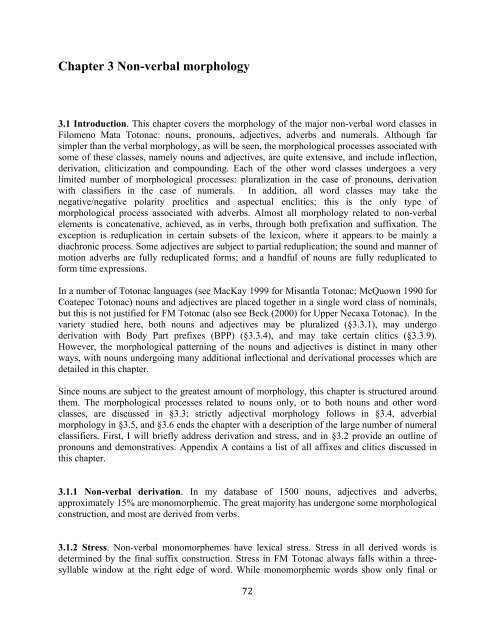The phonology and morphology of Filomeno Mata Totonac
The phonology and morphology of Filomeno Mata Totonac
The phonology and morphology of Filomeno Mata Totonac
Create successful ePaper yourself
Turn your PDF publications into a flip-book with our unique Google optimized e-Paper software.
Chapter 3 Non-verbal <strong>morphology</strong><br />
3.1 Introduction. This chapter covers the <strong>morphology</strong> <strong>of</strong> the major non-verbal word classes in<br />
<strong>Filomeno</strong> <strong>Mata</strong> <strong>Totonac</strong>: nouns, pronouns, adjectives, adverbs <strong>and</strong> numerals. Although far<br />
simpler than the verbal <strong>morphology</strong>, as will be seen, the morphological processes associated with<br />
some <strong>of</strong> these classes, namely nouns <strong>and</strong> adjectives, are quite extensive, <strong>and</strong> include inflection,<br />
derivation, cliticization <strong>and</strong> compounding. Each <strong>of</strong> the other word classes undergoes a very<br />
limited number <strong>of</strong> morphological processes: pluralization in the case <strong>of</strong> pronouns, derivation<br />
with classifiers in the case <strong>of</strong> numerals. In addition, all word classes may take the<br />
negative/negative polarity proclitics <strong>and</strong> aspectual enclitics; this is the only type <strong>of</strong><br />
morphological process associated with adverbs. Almost all <strong>morphology</strong> related to non-verbal<br />
elements is concatenative, achieved, as in verbs, through both prefixation <strong>and</strong> suffixation. <strong>The</strong><br />
exception is reduplication in certain subsets <strong>of</strong> the lexicon, where it appears to be mainly a<br />
diachronic process. Some adjectives are subject to partial reduplication; the sound <strong>and</strong> manner <strong>of</strong><br />
motion adverbs are fully reduplicated forms; <strong>and</strong> a h<strong>and</strong>ful <strong>of</strong> nouns are fully reduplicated to<br />
form time expressions.<br />
In a number <strong>of</strong> <strong>Totonac</strong> languages (see MacKay 1999 for Misantla <strong>Totonac</strong>; McQuown 1990 for<br />
Coatepec <strong>Totonac</strong>) nouns <strong>and</strong> adjectives are placed together in a single word class <strong>of</strong> nominals,<br />
but this is not justified for FM <strong>Totonac</strong> (also see Beck (2000) for Upper Necaxa <strong>Totonac</strong>). In the<br />
variety studied here, both nouns <strong>and</strong> adjectives may be pluralized (§3.3.1), may undergo<br />
derivation with Body Part prefixes (BPP) (§3.3.4), <strong>and</strong> may take certain clitics (§3.3.9).<br />
However, the morphological patterning <strong>of</strong> the nouns <strong>and</strong> adjectives is distinct in many other<br />
ways, with nouns undergoing many additional inflectional <strong>and</strong> derivational processes which are<br />
detailed in this chapter.<br />
Since nouns are subject to the greatest amount <strong>of</strong> <strong>morphology</strong>, this chapter is structured around<br />
them. <strong>The</strong> morphological processes related to nouns only, or to both nouns <strong>and</strong> other word<br />
classes, are discussed in §3.3; strictly adjectival <strong>morphology</strong> follows in §3.4, adverbial<br />
<strong>morphology</strong> in §3.5, <strong>and</strong> §3.6 ends the chapter with a description <strong>of</strong> the large number <strong>of</strong> numeral<br />
classifiers. First, I will briefly address derivation <strong>and</strong> stress, <strong>and</strong> in §3.2 provide an outline <strong>of</strong><br />
pronouns <strong>and</strong> demonstratives. Appendix A contains a list <strong>of</strong> all affixes <strong>and</strong> clitics discussed in<br />
this chapter.<br />
3.1.1 Non-verbal derivation. In my database <strong>of</strong> 1500 nouns, adjectives <strong>and</strong> adverbs,<br />
approximately 15% are monomorphemic. <strong>The</strong> great majority has undergone some morphological<br />
construction, <strong>and</strong> most are derived from verbs.<br />
3.1.2 Stress. Non-verbal monomorphemes have lexical stress. Stress in all derived words is<br />
determined by the final suffix construction. Stress in FM <strong>Totonac</strong> always falls within a threesyllable<br />
window at the right edge <strong>of</strong> word. While monomorphemic words show only final or<br />
! +#!

















